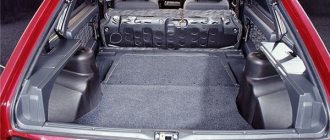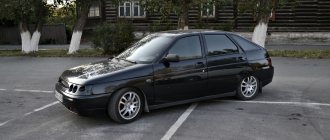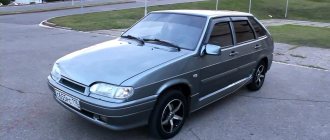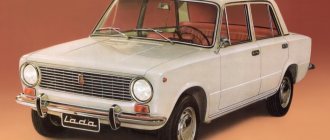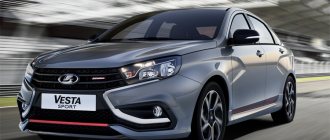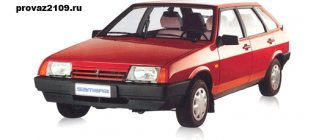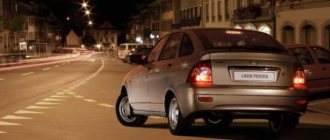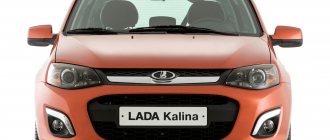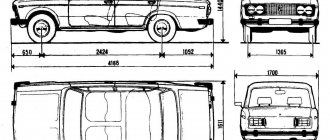Technical characteristics of the VAZ 2108:
1. Engine
2. Dimensions
Other
Other characteristics
Drive unit
- Drive type:
Front
Transmission
- Transmission:
Manual
Suspension
- Front:
independent McPherson type - Rear:
trailing arm
Brakes
- Front:
disc - Rear:
b
Modifications
VAZ-21081
outwardly completely identical to the VAZ-2108, an engine with a volume of 1100 cm3 is installed. The model was mainly exported.
- The VAZ-21083
is completely identical in appearance to the VAZ-2108; it has a 1500 cm3 carburetor engine.
Since 2001, a new model configuration program has been adopted. As a result, the VAZ-21083 model received extended indexes, depending on the configuration:
- VAZ-21083-00 - standard equipment
- VAZ-21083-01 - “norm” equipment
- VAZ-21083-02 - luxury package
The first production injection model VAZ-21083 had the index VAZ-21083-20 and was released in 1994. Since 2001, a new model configuration program was adopted, as a result of which the configuration of the VAZ-21083-20 model was given the name “standard”.
- VAZ-21083-20 - standard equipment
- VAZ-21083-21 - “norm” equipment
- VAZ-21083-22 - luxury package
- VAZ-210834
- In 1998, based on models 21083 and 21213, the VAZ-210834 SUV with engine 21213 and Lada Tarzan with engine 21231 were developed. - VAZ-21084
is completely identical in appearance to the VAZ-2108, it has a 1600 cm3 engine. It is a VAZ-21083 engine with a block increased in height by 1.2 mm, a slightly modified head and a new crankshaft and camshaft. A piston with a diameter of 82 mm, cut in height by 1.8 mm, will have a stroke of 74.8 mm here. It was produced in small batches in pilot production conditions. - VAZ-21085
- identical to the VAZ-2108, but with a 16-valve injection engine with a volume of 1500 cm3 and a power of 93 hp. - VAZ-21086
is a VAZ-2108 model with a right-hand steering wheel. - VAZ-21087
- is a VAZ-21081 model with a right-hand steering wheel. - VAZ-21088
is a VAZ-21083 model with a right-hand steering wheel. - VAZ-21089
is completely identical in appearance to the VAZ-2108, but with a two-section VAZ-414 RPD with a power of 120 hp. It was produced in small batches until the appearance of the new RPD VAZ - 415. Then the VAZ-2108-91 model came to replace it.
Weight and dimensions
Finally, about the load-bearing part. The Eight had a three-door hatchback body. Afterwards, the 5-door hatchback VAZ-2109 and the sedan VAZ-21099 were released on its basis.
The dimensions of the VAZ-2108 were: length - 4.006 m, width -1.75 (including one side mirror), height - 1.402 m. Ground clearance - 170 mm.
The curb weight of the car is 920 kg, and when fully loaded, the Eight weighs more - 1370 kg.
Despite the fact that the model has not been produced for a long time, it still remains popular and is in demand. Moreover, this car is an excellent field for experiments to improve its appearance and technical characteristics.
TTX VAZ 2108
VAZ 2108 is a passenger three-door front-wheel drive hatchback, produced at the Volzhsky Automobile Plant from 1984 to 2003. The Eight became the first Russian car with front-wheel drive, which was not related in design and technology to the classic Zhiguli.
Below are the technical characteristics of the VAZ 2108. The table shows the main characteristics and parameters, body dimensions, type of suspension and steering, as well as permissible loads and weight of the car.
| Main settings | |
| Wheel formula / drive wheels | 4x2 / front |
| Body type / number of doors | hatchback / 3 |
| Car layout diagram | front-wheel drive, front engine, transverse |
| Ground clearance (ground clearance), mm | 170 |
| Fuel tank volume, l | 43 |
| Trunk volume, l | 330 (600) |
| Suspension and chassis | |
| Front suspension | independent, MacPherson-type shock-absorbing strut |
| Rear suspension | Semi-independent, torsion beam |
| Tire size | 165/70 R13 175/70 R13 175/75 R14 |
| Front brakes | disk |
| Rear brakes | drums |
| Wheelbase | |
| Wheelbase, mm | 2460 |
| Front track width, mm | 1400 |
| Rear track width, mm | 1370 |
| Weight, load capacity, permissible loads | |
| Weight, kg | 900 |
| Permissible total weight, kg | 1325 |
| Steering | |
| Steering type | worm gear |
| Dimensions | |
| Length, mm | 4006 |
| Width, mm | 1650 |
| Height, mm | 1402 |
Story
In 1984, a car rolled off the AvtoVAZ assembly lines that was completely different from all previous models. It received the factory designation VAZ-2108.
VAZ-2108
This model can be considered a new era for AvtoVAZ, since the 2108 was different in every way from the classic cars of this manufacturer. This car was initially given the name “Sputnik” (export models had a different name – “Samara”). Subsequently, the domestic name did not really catch on, but at the same time it became the name of a whole family of cars (consisting of only three models), the base for which was the VAZ-2108. Among the people, this car received its own nicknames - “Eight” and “Chisel”. This model lasted on the assembly line until 2004, after which it was replaced by one of the models of the 10-series family.
In general, the “Eight” can be considered the ancestor of all VAZ cars currently produced, since they use the concept of this model.
The VAZ-2108 differed from any classic model in absolutely everything - the body, the power plant and its location, the transmission. Moreover, this car was created practically from scratch, and no components from its predecessors were used in the design. Of course, a lot of things were borrowed from foreign automakers, and designers from other automobile companies, including Porsche, took part in the development of this car, but still the main merit in the creation of domestic designers.
Therefore, it is worth considering this car in more detail, including the design features of the VAZ-2108, technical characteristics, types of power plants, transmissions, body features and weight and dimensions.
Engine characteristics, fuel consumption and acceleration time
| Engine make | VAZ 21081 | VAZ 2108 | VAZ 21080 | VAZ 21083 | VAZ 21083 | VAZ 21083 | VAZ 2111 | VAZ 2112 |
| Engine capacity, cubic meters cm | 1100 | 1289 | 1300 | 1499 | 1499 | 1499 | 1499 | 1499 |
| Number of valves | 8 | 8 | 8 | 8 | 8 | 8 | 8 | 16 |
| Maximum power, hp | 54 | 64 | 63 | 68 | 72 | 76 | 79 | 93 |
| Transmission type | 4 manual transmission | 5 manual transmission | 4 manual transmission | 5 manual transmission | 5 manual transmission | 5 manual transmission | 5 manual transmission | 5 manual transmission |
| Speed at maximum power, rpm | 5600 | 5600 | 5600 | 5600 | 5600 | 5400 | 5400 | 5600 |
| Maximum torque, N*m | 79 | 95 | 95 | 100 | 109 | 116 | 116 | 128 |
| Speed at maximum torque, rpm | 3600 | 3400 | 3400 | 3400 | 3400 | 3000 | 3000 | 3700 |
| engine's type | in-line, 4-cylinder | |||||||
| Supply system | carburetor | carburetor | carburetor | carburetor | carburetor | carburetor | injector | injector |
| Recommended fuel | gasoline AI-92 | gasoline AI-92 | gasoline AI-92 | gasoline AI-92 | gasoline AI-92 | gasoline AI-92 | gasoline AI-95 | gasoline AI-95 |
| Fuel consumption | ||||||||
| Fuel consumption in the urban cycle, l/100 km | 8,7 | 8,6 | 9,1 | 8,7 | 8,8 | 9,9 | 9,9 | 8,8 |
| Fuel consumption in the extra-urban cycle, l/100 km | 5,6 | 5,4 | 5,4 | 5,7 | 5,8 | 5,7 | 5,7 | 5,5 |
| Fuel consumption in the combined cycle, l/100 km | 6,9 | 6,8 | 7 | 7,7 | 7,9 | 7,7 | 7,7 | 6,9 |
| Dynamic indicators | ||||||||
| Acceleration time 0-100 km/h, s | 17 | 16 | 16 | 14 | 13 | 14 | 14 | 13 |
| Maximum speed, km/h | 139 | 148 | 148 | 154 | 157 | 155 | 155 | 160 |
VAZ 2108 was initially equipped with four-cylinder 8-valve carburetor engines of 1.1, 1.3 and 1.5 liters. Since 1994, engines with distributed fuel injection began to be installed on cars. However, this did not stop the production of V8s with carburetor engines.
The main advantages that distinguished cars of this series from other cars of those years were the technical characteristics of the VAZ 2108. In particular, good handling, speed and dynamic qualities, ease of repair, strong front and rear bumpers that could withstand impacts at a speed of 40 km/h , made the car more and more popular every year. Production ceased in 2003.
Why are operational parameters important and what are they?
Here are the main operational characteristics of any cars, including VAZ 2108–2115:
- length;
- body width;
- width according to mirrors;
- wheelbase;
- door sizes;
- empty vehicle weight;
- Curb weight;
- total weight and load capacity.
Vehicle title
This information will help all owners of such cars in a variety of situations. Most of it is indicated in the PTS, that is, the vehicle passport, but some parameters have to be looked up from various sources.
Length
All VAZ 2108–2118 cars are considered relatively small, because their length is a little more than four meters, due to which these models are classified as class “B”, that is, small and budget. The main advantage of this size is high maneuverability, because it is one thing to park in a car 4 m long (2108–2109) and quite another in some Volga or foreign car, the distance between the bumpers of which is 4.7–5.5 m. This is especially relevant in two cases when:
- the vehicle is not equipped with hydraulic (power steering), electric (EUR) or electrohydraulic (EGUR) power steering;
- The driver recently received his license, so he does not yet know how to maneuver correctly in a confined space.
In such conditions, the shorter the length, the easier it is to perform maneuvers.
The length of the vehicle means the distance between the most protruding parts of the front/rear bumpers in mm, which for VAZ car models is:
- 2108 (hatchback 3 doors) – 4006.
- 2109 (hatchback 5 doors) – 4006.
- 21099 (sedan) – 4205.
- 2110 (sedan) – 4265.
- 2111 (station wagon) – 4285.
- 2112 (hatchback 5 doors) – 4170.
- 21123 (hatchback 3 doors) – 4193.
- 2113 (hatchback 3 doors) – 4122.
- 2114 (hatchback 5 doors) – 4122.
- 2115 (sedan) – 4330.
Dimensions of VAZ 2115 and VAZ 2114
The shortest are the hatchbacks of the Samara-1 family (VAZ 2108–21099), and the longest model is the sedan of the Samara-2 family (VAZ 2113–2115). Representatives of the “Tenth” family (VAZ 2110–2112) occupy the middle place. Moreover, in any family, the hatchback body type is always shorter than the sedan or station wagon. Most likely, this is due to the sportier appearance of such a car, which looks more nimble than a leisurely sedan or a heavy and load-lifting station wagon.
Despite the fact that from a distance all the vehicles of these models look approximately the same, the difference of 32.4 cm between 2108–2109 and 2115 is quite significant: the Eight and Nine will require a smaller garage than the Fifteen. And in a densely packed parking lot, where you often meet those who abandon their iron horse as necessary, smaller sizes will help you squeeze into places where a larger passenger car will not fit.
Body width
All cars of class “B” are distinguished by the fact that the width of the body does not exceed 169 cm. This is quite enough for 5 people with an average weight of 80 kg to fit into the cabin, however, they will not be very comfortable sitting in the back seat, which is also called a sofa, because due to lack of space. Although, due to the low cost of all cars of this class, their owners do not consider insufficient width a serious problem, because you can always buy a class “C” or “D” passenger car. There, this parameter often goes beyond 1.8 m, so there is much more space on the sofa.
Here are the body width dimensions in mm:
- "Samara-1" - 1650.
- “Tenth” family – 1680.
- "Samara-2" - 1650.
Width of VAZ 2110
The bodies of both Samara families are the same in width, and the tenth family is 3 cm larger than them, that is, it is at least a little more comfortable.
Width by mirrors
This parameter does not affect the capacity of the passenger vehicle, but it determines how much space the vehicle will take up in the parking lot or garage, in other words, it describes the dimensions of the car. The problem is that the standard mirrors of all cars of these types are not very well shaped and relatively small in size, so some drivers replace them with more convenient and larger analogues.
With standard mirrors, the width is (in mm):
- "Samara-1" - 1850.
- “Tenth” family – 1875.
- "Samara-2" - 1970.
Mirrors 2110–2112 are slightly larger than those installed on both generations of Samara, so the increase in overall width turned out to be 5 cm more. Moreover, the trend towards larger mirrors continued on subsequent models - these details became much more convenient and informative.
Wheelbase
The term "wheelbase" describes the distance between the axles of the front and rear wheels. Despite the fact that it does not directly say anything about the comfort of a passenger car, it can be used to draw a conclusion about how spacious the vehicle’s interior is. After all, the rear seat is located in the area of the rear axle, and the legs of the front passenger and driver are next to the front wheel, therefore, the longer the wheelbase, the more spacious the cabin will be.
For products of the AvtoVAZ concern, this parameter is in mm:
- "Samara-1", "Samara-2" - 2460.
- 2110, 2111 21123 – 2492.
- 2112 – 2489.
Dimensions of VAZ 2111
Since the Samara-2 family was only an improvement on the once popular 2108–21099, and the Tenth family was an attempt to develop something new, more in line with modern requirements, its wheelbase turned out to be a little larger.
Door sizes
This parameter shows how comfortable it is to get into the car, especially for large people, because the larger the doorway, the less you will have to squeeze to squeeze through it. For three-door hatchbacks, the size of the doors determines how convenient it will be for passengers in the rear seats to get into the cabin, because they will have to squeeze into the space between the doorway and the front seat. To determine this parameter, take into account the geometry of the part and measure the door at the point of greatest width, then approximately at the level of the door handle. Here are the dimensions of the doors of VAZ 2108–2115 cars:
| Model | Front door size, mm | Rear door size, mm |
| 2108 | 1232 | No |
| 2109 | 963 | 860 |
| 21099 | 963 | 860 |
| 2110 | 970 | 898 |
| 2111 | 900 | 898 |
| 2112 | 900 | 898 |
| 21123 | 1160 | No |
| 2113 | 1232 | No |
| 2114 | 963 | 860 |
| 2115 | 963 | 860 |
Door sizes
When developing the “Tenth” series, Avtovaz JSC engineers slightly enlarged the rear doors of the sedan and hatchback bodies compared to the Samara-1 and Samara-2 families, then the same trend continued on the Priors.
Empty weight
In the opinion of some owners of such vehicles, the weight of a VAZ 2109 in kg is a useless parameter, because it does not directly affect its operation, but this opinion is extremely erroneous. After all, the mass of an empty vehicle consists of the weight:
- motor;
- body;
- gearboxes;
- wheels;
- other systems and elements.
The heaviest parts of any car are the body and engine; all other elements and systems are much lighter.
Body
The weight of the body of a VAZ 2109 car or any other model shows how thick the metal was used for its manufacture, and therefore what is the level of its passive safety. On average, this parameter is 300–350 kg (excluding doors and other attachments), but if you analyze it taking into account the length and weight of the empty vehicle, you get a more objective picture. We have compiled a table that summarizes all these parameters:
| Model | Length, mm | Approximate weight of an empty vehicle, kg | Empty body weight, kg |
| 2108 | 4006 | 900–1015 | 330 |
| 2109 | 4006 | 915–1015 | 330 |
| 21099 | 4205 | 960–990 | 300 |
| 2110 | 4265 | 1010–1100 | 330 |
| 2111 | 4285 | 1040–1055 | 330 |
| 2112 | 4170 | 1040–1055 | 330 |
| 21123 | 4193 | 1040–1055 | 330 |
| 2113 | 4122 | 970–1060 | 330 |
| 2114 | 4122 | 985–110 | 330 |
| 2115 | 4330 | 970–1100 | 300 |
Hatchbacks of the Samara-1 and Samara-2 families are the best in terms of body weight to vehicle weight ratio, and models 2108–2109 are also the shortest, making them stronger than what AvtoVAZ JSC produced after. And this is not surprising, because the weight of the VAZ 2109 car was calculated according to Soviet standards, and no matter what they say about the USSR auto industry, this country made cars with impact-resistant bodies. At the same time, for the much longer VAZ 2115, the weight of the car remained the same, that is, manufacturers saved as much as possible on body metal.
Body weight of VAZ 2110
Her predecessor had a similar story, who was born in the most difficult time, not counting the Great Patriotic War, in December 1990. Like its descendant from the Samara-2 family, the VAZ 21099 in the basic version weighed 960 kg, which is noticeably more than the weight of the Eight and Nine, while the body was made lighter, which was affected by the shortage of everything, including become.
By the beginning of the new millennium, the situation in the country had stabilized; there was a demand for passenger cars that could compete with budget foreign cars, but retained all the best of what was made in the USSR. Therefore, the VAZ 2114, which became the heir to the legendary “Nine” (at one time AvtoVAZ produced both models), retained the original weight of the car and the weight of the body, although it became a little longer due to a larger plastic bumper.
The weight of the VAZ 2112, as well as the entire “Tenth” family, is slightly greater than that of both generations of “Samara”, but thanks to the slightly increased length the ratio remains the same, thanks to which the transitional models retained the Soviet ratio of length and weight.
Motors
The weight of all engines of models 2108–2115 depends on the type (carburetor or injector), volume and number of valves:
- 21083 (carburetor eight-valve, 1.5 l), 2110 (eight-valve carburetor 1.5 l) and 2111 (injection eight-valve 1.5 l) - 127 kg.
- 21114, also known as 1116 (injection eight-valve 1.6 l), 21124 (injection sixteen-valve 1.6 l) - 121 kg.
- 2112 (injection sixteen-valve 1.5 l) – 120.
- Opel C20XE (injection, sixteen-valve, 2 l) – 136 kg.
Engine VAZ 2108
All production engines that were installed on these models weigh on average 125 kg, with the exception of the Opel two-liter power unit, which weighs 136 kg. But it is extremely difficult to find a live “Ten” with such an engine, because very few of them were produced. This information will be useful for those who plan to remove the motor for repair/replacement or sell it for scrap.
Remember, it doesn’t matter whether you have a VAZ 2114 or some other model, the weight of the car’s engine is always noticeably over 100 kg, so you can remove and install it alone only if you have special equipment, at least a traverse with a winch.
Boxes, wheels and more
The five-speed transmissions of all models 2108–2115 weigh approximately the same, 37±3 kg, so removing and installing them alone is problematic. Especially if there is no full-fledged concrete pit and a motor rack on wheels. If you are planning to carry out any work that involves removing the manual transmission, but you do not have a hole, but only a flat area, then stock up on rolling jacks, they will make the work much easier. The weight of other parts and systems for all is 2108–2115, depending on the modification and configuration of the vehicle. Therefore, the weight of the additional equipment of a car with air conditioning will always be greater than that of a vehicle without this device.
VAZ five-speed gearbox
Remember that the weight of the wheels depends not so much on the diameter of the disk, but on its type and tire size, so each wheel weighs 7–20 kg, and we are only talking about diameters R13 and R14, suitable for these products of the Soviet-Russian automobile industry.
In addition to the wheels, these vehicles have another heavy part - the rear beam, which weighs 13–14 kg.
In addition, there are additional body elements, such as:
- doors;
- trunk;
- hood.
Their weight depends only on the type of body, so the doors of a three-door hatchback will always be heavier than those of a sedan or five-door modification, and the trunk of the sedan and station wagon of the “Tenth” family will weigh more than others.
Gross weight and load capacity
Inexperienced drivers who did not listen attentively to the instructor at a driving school sometimes confuse the terms “curb” and “gross” weight of a passenger car. The first indicates the weight of a VAZ 2110 car or any other model, with:
- full tank of gasoline;
- filled with technical fluids (engine and transmission oil, antifreeze, brake);
- standard tools (jack, wheel wrench, warning triangle and first aid kit);
- driver weighing 75 kg.
This option is important if you have to drive alone where there are vehicle weight restrictions, such as across a rotten or broken bridge. The second parameter shows how much weight the car can carry when normally loaded. In addition, it is important if you are going to travel with your whole family in your car and part of the journey will have to be done by ferry or some other vehicle, and your Lada will be one of the passengers.
What does the “gross” weight of a car consist of?
The standard load capacity of models 2108–2115 is 350–390 kg and depends on the installed springs and shock absorbers, and the model does not matter.
VAZ 2108 dimensions and weight
Dimensions Lada 2108 restyling 1991, hatchback 3 doors, 1st generation
04.1991 — 09.2004
| Options | Dimensions | Weight, kg |
| 1.1MT 21081 | 4006 x 1650 x 1402 | 900 |
| 1.3MT 21080 | 4006 x 1650 x 1402 | 900 |
| 1.3MT 21086 | 4006 x 1650 x 1402 | 900 |
| 1.5 MT 21085-20 Standard | 4006 x 1650 x 1402 | 905 |
| 1.5i MT 21085-21 Normal | 4006 x 1650 x 1402 | 905 |
| 1.5i MT 21085-22 Lux | 4006 x 1650 x 1402 | 905 |
| 1.5 MT 21083-00 Standard | 4006 x 1650 x 1402 | 915 |
| 1.5 MT 21083-01 Norm | 4006 x 1650 x 1402 | 915 |
| 1.5 MT 21083-02 Lux | 4006 x 1650 x 1402 | 915 |
| 1.5 MT 21083-00 Standard | 4006 x 1650 x 1402 | 920 |
| 1.5 MT 21083-01 Norm | 4006 x 1650 x 1402 | 920 |
| 1.5 MT 21083-02 Lux | 4006 x 1650 x 1402 | 920 |
| 1.5i MT 21083-20 Standard | 4006 x 1650 x 1402 | 920 |
| 1.5i MT 21083-21 Normal | 4006 x 1650 x 1402 | 920 |
| 1.5i MT 21083-22 Lux | 4006 x 1650 x 1402 | 920 |
| 1.6MT 21084 | 4006 x 1650 x 1402 | 920 |
| 1.3MT 2108-91 | 4006 x 1650 x 1402 | 1015 |
Dimensions Lada 2108 1984, hatchback 3 doors, 1st generation
10.1984 — 08.1993
| 1.1MT 21081 | 4006 x 1650 x 1402 | 900 |
| 1.3MT 21080 | 4006 x 1650 x 1402 | 900 |
| 1.3MT 21086 | 4006 x 1650 x 1402 | 900 |
| 1.5 MT 21085-20 Standard | 4006 x 1650 x 1402 | 905 |
| 1.5i MT 21085-21 Normal | 4006 x 1650 x 1402 | 905 |
| 1.5i MT 21085-22 Lux | 4006 x 1650 x 1402 | 905 |
| 1.5 MT 21083-00 Standard | 4006 x 1650 x 1402 | 920 |
| 1.5 MT 21083-01 Norm | 4006 x 1650 x 1402 | 920 |
| 1.5 MT 21083-02 Lux | 4006 x 1650 x 1402 | 920 |
| 1.5i MT 21083-20 Standard | 4006 x 1650 x 1402 | 920 |
| 1.5i MT 21083-21 Normal | 4006 x 1650 x 1402 | 920 |
| 1.5i MT 21083-22 Lux | 4006 x 1650 x 1402 | 920 |
| 1.3MT 2108-91 | 4006 x 1650 x 1402 | 1015 |
Fuel consumption VAZ 2108
Fuel consumption Lada 2108 restyling 1991, hatchback 3 doors, 1st generation
04.1991 — 09.2004
| Modification | Fuel consumption, l/100 km | Fuel used |
| 1.3 l, 63 hp, gasoline, manual transmission, front-wheel drive | 5,4 | Gasoline AI-95 |
| 1.1 l, 54 hp, gasoline, manual transmission, front-wheel drive | 5,6 | Gasoline AI-95 |
| 1.3 l, 64 hp, gasoline, manual transmission, front-wheel drive | 6,8 | Gasoline AI-95 |
| 1.5 l, 79 hp, gasoline, manual transmission, front-wheel drive | 7,7 | Gasoline AI-95 |
| 1.5 l, 76 hp, gasoline, manual transmission, front-wheel drive | 7,7 | Gasoline AI-95 |
| 1.5 l, 68 hp, gasoline, manual transmission, front-wheel drive | 7,7 | Gasoline AI-95 |
| 1.5 l, 93 hp, gasoline, manual transmission, front-wheel drive | 8,8 | Gasoline AI-95 |
| 1.3 l, 140 hp, gasoline, manual transmission, front-wheel drive | 10,0 | Gasoline AI-95 |
Fuel consumption Lada 2108 1984, hatchback 3 doors, 1st generation
10.1984 — 08.1993
| 1.3 l, 63 hp, gasoline, manual transmission, front-wheel drive | 5,4 | Gasoline AI-95 |
| 1.1 l, 54 hp, gasoline, manual transmission, front-wheel drive | 5,6 | Gasoline AI-95 |
| 1.3 l, 64 hp, gasoline, manual transmission, front-wheel drive | 6,8 | Gasoline AI-95 |
| 1.5 l, 79 hp, gasoline, manual transmission, front-wheel drive | 7,7 | Gasoline AI-95 |
| 1.5 l, 76 hp, gasoline, manual transmission, front-wheel drive | 7,7 | Gasoline AI-95 |
| 1.5 l, 68 hp, gasoline, manual transmission, front-wheel drive | 7,7 | Gasoline AI-95 |
| 1.5 l, 93 hp, gasoline, manual transmission, front-wheel drive | 8,8 | Gasoline AI-95 |
| 1.3 l, 140 hp, gasoline, manual transmission, front-wheel drive | 10,0 | Gasoline AI-95 |
Tank volume VAZ 2108
Tank volume Lada 2108 restyling 1991, hatchback 3 doors, 1st generation
04.1991 — 09.2004
| Options | Fuel tank volume, l |
| 1.1MT 21081 | 43 |
| 1.3MT 2108-91 | 43 |
| 1.3MT 21080 | 43 |
| 1.3MT 21086 | 43 |
| 1.5 MT 21083-00 Standard | 43 |
| 1.5 MT 21083-01 Norm | 43 |
| 1.5 MT 21083-02 Lux | 43 |
| 1.5i MT 21083-20 Standard | 43 |
| 1.5i MT 21083-21 Normal | 43 |
| 1.5i MT 21083-22 Lux | 43 |
| 1.5 MT 21085-20 Standard | 43 |
| 1.5i MT 21085-21 Normal | 43 |
| 1.5i MT 21085-22 Lux | 43 |
| 1.6MT 21084 | 43 |
Tank volume Lada 2108 1984, hatchback 3 doors, 1st generation
10.1984 — 08.1993
| 1.1MT 21081 | 43 |
| 1.3MT 2108-91 | 43 |
| 1.3MT 21080 | 43 |
| 1.3MT 21086 | 43 |
| 1.5 MT 21083-00 Standard | 43 |
| 1.5 MT 21083-01 Norm | 43 |
| 1.5 MT 21083-02 Lux | 43 |
| 1.5i MT 21083-20 Standard | 43 |
| 1.5i MT 21083-21 Normal | 43 |
| 1.5i MT 21083-22 Lux | 43 |
| 1.5 MT 21085-20 Standard | 43 |
| 1.5i MT 21085-21 Normal | 43 |
| 1.5i MT 21085-22 Lux | 43 |
How much can you get if you sell your car for scrap?
As practice shows, the price per ton of scrap metal when handing over a fully equipped car varies from 7,000 rubles and more. By handing over a car body that has been cleared of non-metallic inclusions, you can expect a reward of 9,000 or more.
Interesting materials:
How much sugar can you have per day? How much sugar is in natural apple juice? How many MMRs can you calibrate now? How many MOTs are there now in the Rostov region? How long does it take to study to become a doctor now? How many seeds are in a pine cone? How much silver is in the Order? How many episodes of the series Gloomy River? How many episodes is the Gloomy River movie? How many episodes are there in Lilo and Stitch?
Acceleration to 100 in Lada 2108
Acceleration to 100 in Lada 2108 restyling 1991, hatchback 3 doors, 1st generation
04.1991 — 09.2004
| Modification | Acceleration to 100 km/h |
| 1.3 l, 140 hp, gasoline, manual transmission, front-wheel drive | 8 |
| 1.5 l, 70 hp, gasoline, manual transmission, front-wheel drive | 13 |
| 1.5 l, 72 hp, gasoline, manual transmission, front-wheel drive | 13 |
| 1.5 l, 93 hp, gasoline, manual transmission, front-wheel drive | 13 |
| 1.5 l, 68 hp, gasoline, manual transmission, front-wheel drive | 14 |
| 1.5 l, 76 hp, gasoline, manual transmission, front-wheel drive | 14 |
| 1.5 l, 79 hp, gasoline, manual transmission, front-wheel drive | 14 |
| 1.3 l, 63 hp, gasoline, manual transmission, front-wheel drive | 16 |
| 1.3 l, 64 hp, gasoline, manual transmission, front-wheel drive | 16 |
| 1.1 l, 54 hp, gasoline, manual transmission, front-wheel drive | 17 |
| 1.6 l, 83 hp, gasoline, manual transmission, front-wheel drive | 17 |
Acceleration to 100 in Lada 2108 1984, hatchback 3 doors, 1st generation
10.1984 — 08.1993
| 1.3 l, 140 hp, gasoline, manual transmission, front-wheel drive | 8 |
| 1.5 l, 72 hp, gasoline, manual transmission, front-wheel drive | 13 |
| 1.5 l, 93 hp, gasoline, manual transmission, front-wheel drive | 13 |
| 1.5 l, 68 hp, gasoline, manual transmission, front-wheel drive | 14 |
| 1.5 l, 76 hp, gasoline, manual transmission, front-wheel drive | 14 |
| 1.5 l, 79 hp, gasoline, manual transmission, front-wheel drive | 14 |
| 1.3 l, 63 hp, gasoline, manual transmission, front-wheel drive | 16 |
| 1.3 l, 64 hp, gasoline, manual transmission, front-wheel drive | 16 |
| 1.1 l, 54 hp, gasoline, manual transmission, front-wheel drive | 17 |
Transmission
Next, let's look at the technical characteristics of the VAZ-2108 transmission. This car used a three-shaft type gearbox (4 or 5-speed) and with a differential installed in the crankcase. It was controlled by a lever installed in the cabin. But since both the power plant and the gearbox were located transversely, gear shifting was carried out not directly (as in classic models), but through remote traction. The amount of oil in the VAZ-2108 gearbox was: 4-speed version - 3.0 liters, 5- fast - 3.3 liters. Transmission oil was poured into the VAZ-2108 gearbox. The clutch was single-plate, dry type and cable driven.
New transmission
Despite the differential installed in the crankcase, the dimensions of the VAZ-2108 gearbox were smaller than those of the classic versions.
Related link:
Homemade pre-heater for a VAZ car engine
Both types of gearbox were installed only on the 1.3-liter version. The 1.1-liter engine was not equipped with a 5-speed gearbox, and all 1.5-liter modifications were not equipped with a 4-speed gearbox.
It is noteworthy that the characteristics of both boxes are identical, and the difference comes down only to the presence/absence of 5th speed.
The gear ratios of the VAZ-2108 gearbox of both versions up to 5th gear are the same, and they are all shown in the table:
| Gear ratios of the VAZ-2108 gearbox | |
| Speed | Meaning |
| 1st | 3,636 |
| 2nd | 1,95 |
| 3rd | 1,357 |
| 4th | 0,941 |
| 5th | 0,784 |
| Rear | 3,53 |
The drive from the box to the drive wheels was carried out using two drive shafts, each of which in its design had two ball-type equal angular velocity joints.
Next is the dynamic and speed characteristics of the VAZ-2108 car with different technical equipment. Naturally, the weakest according to these data is the 1.1-liter version. Its maximum speed is only 140 km/h, and it accelerates to 100 km/h in 22 seconds. Its average gasoline consumption is 7.9 liters.
The speed characteristics of the VAZ-2108 with a 1.3-liter unit and both versions of the gearbox have a maximum of 148 km/h, and this version reaches 100 km/h in 19 seconds. But the presence of 5th speed affects gas mileage. The version with a 4-speed gearbox consumes an average of 8.2 liters, and the presence of an additional speed made it possible to reduce this figure to 7.8 liters.
The 1.5-liter version of the V8 with a different power system and 5-speed gearbox has almost identical performance. The maximum speed of these modifications is 156 km/h, but the dynamic performance and fuel consumption vary slightly. The carburetor version accelerates to 100 km/h in 15 seconds, while the injection version does it 0.5 seconds faster.
As for consumption, the carburetor consumes 8.0 liters on average, and the injector consumes 7.7 liters.
Ground clearance VAZ 2108
Ground clearance Lada 2108 restyling 1991, hatchback 3 doors, 1st generation
04.1991 — 09.2004
| Options | Ground clearance, mm |
| 1.1MT 21081 | 170 |
| 1.3MT 2108-91 | 170 |
| 1.3MT 21080 | 170 |
| 1.3MT 21086 | 170 |
| 1.5 MT 21083-00 Standard | 170 |
| 1.5 MT 21083-01 Norm | 170 |
| 1.5 MT 21083-02 Lux | 170 |
| 1.5i MT 21083-20 Standard | 170 |
| 1.5i MT 21083-21 Normal | 170 |
| 1.5i MT 21083-22 Lux | 170 |
| 1.5 MT 21085-20 Standard | 170 |
| 1.5i MT 21085-21 Normal | 170 |
| 1.5i MT 21085-22 Lux | 170 |
| 1.6MT 21084 | 170 |
Ground clearance Lada 2108 1984, hatchback 3 doors, 1st generation
10.1984 — 08.1993
| 1.1MT 21081 | 170 |
| 1.3MT 2108-91 | 170 |
| 1.3MT 21080 | 170 |
| 1.3MT 21086 | 170 |
| 1.5 MT 21083-00 Standard | 170 |
| 1.5 MT 21083-01 Norm | 170 |
| 1.5 MT 21083-02 Lux | 170 |
| 1.5i MT 21083-20 Standard | 170 |
| 1.5i MT 21083-21 Normal | 170 |
| 1.5i MT 21083-22 Lux | 170 |
| 1.5 MT 21085-20 Standard | 170 |
| 1.5i MT 21085-21 Normal | 170 |
| 1.5i MT 21085-22 Lux | 170 |
Trunk volume of VAZ 2108
Trunk volume Lada 2108 restyling 1991, hatchback 3 doors, 1st generation
04.1991 — 09.2004
| Options | Trunk capacity, l |
| 1.1MT 21081 | 330 |
| 1.3MT 2108-91 | 330 |
| 1.3MT 21080 | 330 |
| 1.3MT 21086 | 330 |
| 1.5 MT 21083-00 Standard | 330 |
| 1.5 MT 21083-01 Norm | 330 |
| 1.5 MT 21083-02 Lux | 330 |
| 1.5i MT 21083-20 Standard | 330 |
| 1.5i MT 21083-21 Normal | 330 |
| 1.5i MT 21083-22 Lux | 330 |
| 1.5 MT 21085-20 Standard | 330 |
| 1.5i MT 21085-21 Normal | 330 |
| 1.5i MT 21085-22 Lux | 330 |
| 1.6MT 21084 | 330 |
Trunk volume Lada 2108 1984, hatchback 3 doors, 1st generation
10.1984 — 08.1993
| 1.1MT 21081 | 330 |
| 1.3MT 2108-91 | 330 |
| 1.3MT 21080 | 330 |
| 1.3MT 21086 | 330 |
| 1.5 MT 21083-00 Standard | 330 |
| 1.5 MT 21083-01 Norm | 330 |
| 1.5 MT 21083-02 Lux | 330 |
| 1.5i MT 21083-20 Standard | 330 |
| 1.5i MT 21083-21 Normal | 330 |
| 1.5i MT 21083-22 Lux | 330 |
| 1.5 MT 21085-20 Standard | 330 |
| 1.5i MT 21085-21 Normal | 330 |
| 1.5i MT 21085-22 Lux | 330 |
VAZ-2108 technical characteristics
| Geometric diagram of VAZ-2101 | |||
| Engine Modifications | 1.3 l. 8th grade | 1.5 l. 8th grade | 1.5 l. 16 classes |
| Body type/number of doors | hatchback / 3 | ||
| Vehicle layout | Front-wheel drive, front engine, transverse | ||
| Wheel formula | 4 x 2 | 4 x 2 | 4 x 2 |
| Length, mm | 4006 | 4006 | 4006 |
| Width, mm. | 1620 | 1620 | 1620 |
| Height, mm. | 1335 | 1335 | 1335 |
| Wheelbase, mm. | 2460 | 2460 | 2460 |
| Ground clearance, mm. | 160 | 160 | 160 |
| Front track, mm. | 1400 | 1400 | 1400 |
| Rear track, mm. | 1370 | 1370 | 1370 |
| Curb weight, kg. | 930 | 930 | 930 |
| Total weight, kg. | 1305 | 1305 | 1305 |
| Engine | |||
| Engine | 1.3 l. 8th grade | 1.5 l. 8th grade | 1.5 l. 8th grade |
| engine's type | 4-cylinder carburetor | ||
| Engine location | Front, across | ||
| Supply system | carburetor "Solex 1107010" | ||
| Number of cylinders | 4 | 4 | 4 |
| Cylinder diameter, mm. | 76 | 82 | 82 |
| Piston stroke, mm. | 71 | 71 | 71 |
| Compression ratio | 9,9 | 9,9 | 9,9 |
| Number of valves | 2 | 2 | 2 |
| Engine capacity, cm.3 | 1288 | 1499 | 1499 |
| Maximum power, kW/rpm | 64/5600 | 68/5600 | 78/5600 |
| Maximum torque Nm/rpm | 95/3400 | 100/3400 | 116/3400 |
| Front suspension type | MacPherson struts with steering knuckles | ||
| Rear suspension type | torsion-lever | ||
| Steering type | rack and pinion with steering rods | ||
| Brake system | double-circuit, with diagonal position of the circuits, hydraulic drive and vacuum booster. | ||
| Front/rear brakes | disc/drum | ||
| Hand brake | mechanical with cable drive | ||
| Transmission VAZ-2101 | |||
| Gearbox type / number of gears | Mechanical / 5 three-shaft type | ||
| Gear ratios of the VAZ-2108 gearbox | |||
| 1st gear | 3,636 | ||
| 2nd gear | 1,95 | ||
| 9th gear | 1,357 | ||
| 4th gear | 0,941 | ||
| 5th gear | 0,784 | ||
| reverse gear | 3,53 | ||
| Clutch | single-disc, dry with cable drive | ||
| Dynamics of VAZ-2108 | |||
| Oil volume in gearbox, l. | 3,3 | 3,3 | 3,3 |
| Maximum speed | 148 km/h | 154 km/h | 155 km/h |
| Acceleration time (0-100km/h), sec. | 16 | 14 | 13 |
| Tire size | 155SR15 | 155SR15 | 155SR15 |
| Fuel consumption in the city/on the highway | 8.3 l. | 8.7 l. | 9.9 l. |
| Fuel | AI-92 | AI-92 | AI-95. |
| Trunk volume, l. | ? | ? | ? |
| Fuel tank volume, l. | 43 | 43 | 43 |
Engines and their characteristics
Let's start with the power units. For this car, several main engines with different volumes and technical specifications were provided. characteristics. But the VAZ-2108 engine diagram is the same for everyone.
Related link:
Description and installation of the “Lunfey” heater on a VAZ
These were 4-cylinder engines with an upper timing belt (8-valve) and camshaft. A distinctive feature from the installations of previous models was the belt drive of the gas distribution mechanism. The method of regulating the thermal clearance of the valves has also changed - rockers were abandoned in favor of shims.
The power system was initially carburetor, but later it was replaced with an injector. Cooling is liquid type with forced circulation of coolant (its volume was 7.8 liters for all types of engines).
Eight engine
The lubrication system is of a combined type (some components were lubricated under pressure, while others were lubricated by splashing). The engine oil required was 3.5 liters.
Initially, the engines used a non-contact ignition system, but after that it was replaced with a microprocessor one (it was used on both carburetor and injection versions).
Finally, perhaps one of the most remarkable features - the engine was located transversely in the engine compartment, which made it possible to increase the space in the cabin, reduce the size of the hood and position it at an angle.
Now about what technical characteristics the VAZ-2108 had. The main powerplants available were: 1.1-litre, 1.3-litre and 1.5-litre. The markings of VAZ-2108 engines were taken according to the brand designation (except for the injection model). So, the base model was considered to be with a 1.3-liter engine, and it was designated as VAZ-2108. And for other versions, to indicate the installed motor, a number was added to the index. As a result, the 1.1-liter version was labeled as VAZ-21081, and the 1.5-liter - 21083.
They did not use such a designation for the injection engine, and it was designated as VAZ-2111.
Next, let's look at what characteristics each VAZ-2108 engine had. So, the basic version was without additional indexes. The VAZ-2108 engine capacity was 1.3 liters, which allowed it to develop a power of 63.7 hp. s., and the maximum torque was 94 Nm at 3600 rpm. crankshaft.
Related link:
How to start a VAZ engine in winter
The VAZ-2108 with a 1.1-liter engine was obtained after some processing of the base engine (the piston stroke was reduced), thereby affecting the volume. This engine produced only 53.9 liters. s., and the torque was 79 Nm at the same engine speeds as indicated above.
The characteristics of the VAZ-2108 with 1.5 liters of volume and a carburetor power system were: power - 70 liters. s., torque – 106 Nm at 3400 rpm.
The VAZ-2111 engine installed on the G8 was practically no different in performance from the carburetor version. Their power was the same, but the torque of the injection model was slightly higher than 115 Nm.
These were the main versions of power plants described. But the plant also produced a model equipped with a VAZ-415 rotary piston engine (Wankel engine). This installation had the best performance; it developed 140 hp. With. With a torque of 186 Nm. It was a two-chamber unit with a carburetor power system. But since the service life of the VAZ-415 engines was not very long, this version of the Eight was not particularly popular.
